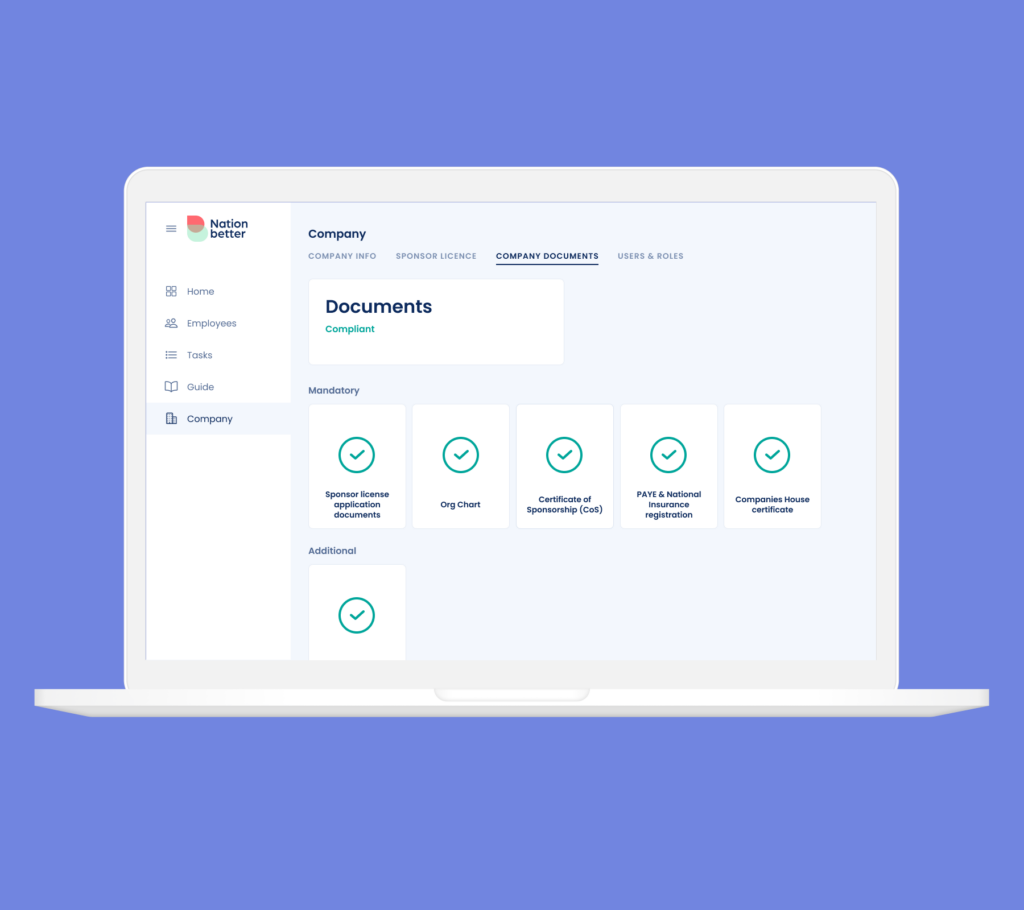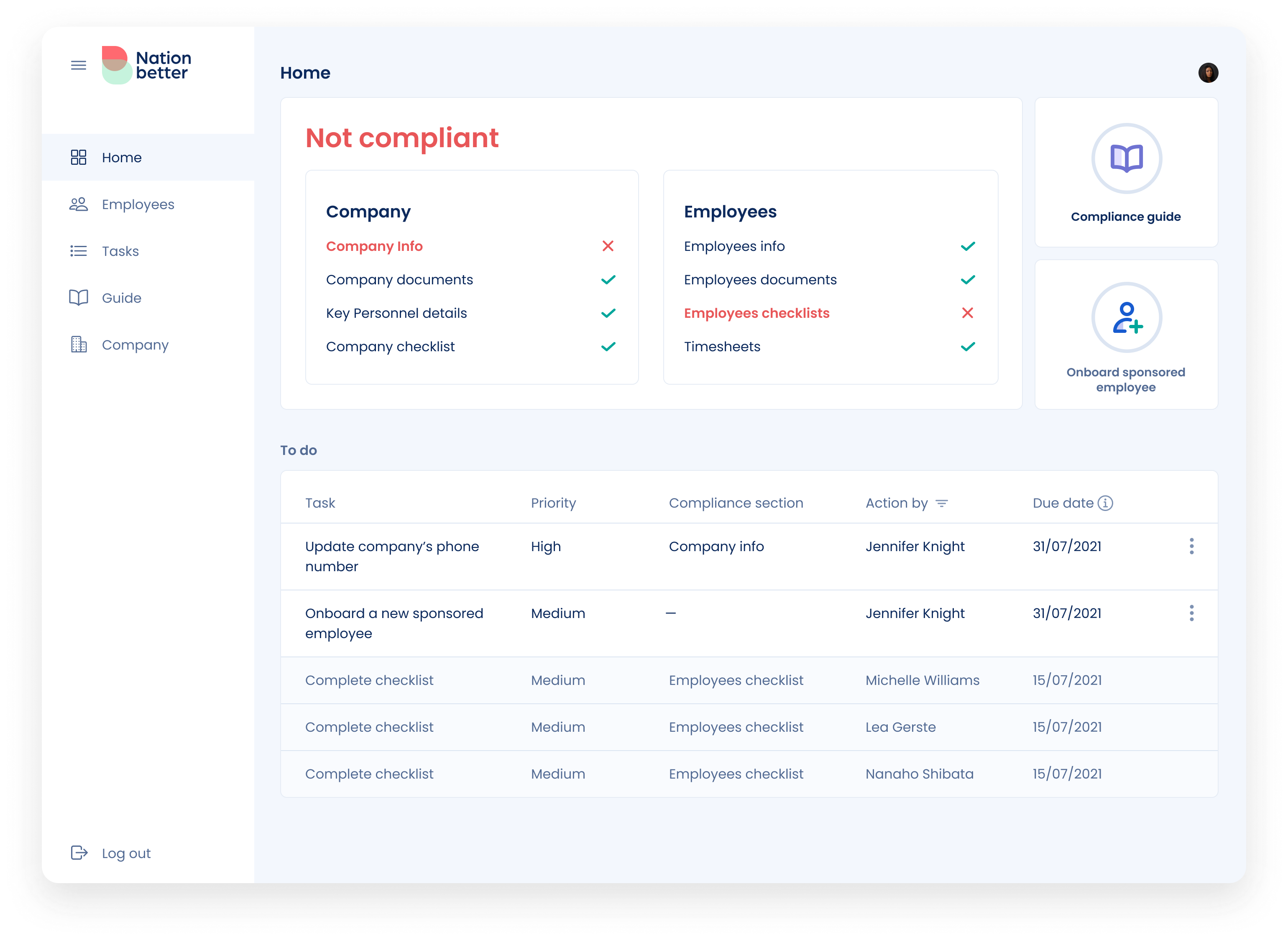A complete guide for a successful sponsor licence application

A complete guide for a successful sponsor licence application
You may already know that obtaining a sponsor licence is the first step you need to take if you’re looking to employ international workers in the UK.
But, the process of obtaining the sponsor licence is not easy.
So, if you’re wondering how you can apply for a sponsor licence, here’s everything you need to know for a successful sponsor licence application.
How to obtain a sponsor licence?
The process of applying for a sponsor licence includes the following steps:
- Ensure that your business is eligible for a sponsor licence
- Ensure that the job you’re offering is suitable for sponsorship
- Choose the type of licence you want
- Appoint key personnel to manage your sponsorship activities
- Complete the online application, submit the support documents, and pay the fees
1. Eligibility requirements
- Prior to completing the online sponsor licence application form, please ensure you fully qualify to become a registered sponsor. Before the Home Office can grant your company a sponsor licence, they’ll need to establish that the following criteria are met.
- The company is a genuine organisation based in the UK (it can also be a UK branch of an international company) operating lawfully in the UK. This should be backed by supporting documents specific to the company’s sector of operation. Nation.better experts can help you with the full list of documents required.
- Depending on the circumstances, you may apply for one licence covering all the UK branches or a separate licence can be obtained for each branch.
- The key personnel named in the application, and any people involved in the day-to-day running of the business should be honest and reliable, and should not be engaged—at present or in the past—in behaviour or actions that are not conducive to the public good.
- You are capable of carrying out your sponsor duties and evidencing your compliance in accordance with sponsor duties and compliance requirements. This is generally checked by looking at your human resources and recruitment practices to make sure you will be able to fulfil your sponsor duties. Please note that the Home Office staff may visit your organisation before the licence is granted.
- The vacant jobs for which you intend to assign a Certificate of Sponsorship (CoS) are identified. If you have already identified someone that you wish to employ, you should provide evidence of the process. If you identified this person as a result of a recruitment process, you should clarify where you advertised the position and provide the details of the recruitment agency if they assisted you with the candidate.
- You should confirm whether the person is already working for you (if they are in the UK, for instance, as a student).
- You can confirm how you identified this person as the most suitable for the job if you have not advertised the job and the person you wish to employ is not currently working for you.
- You can prove to the Home Office that the vacancy is genuine, you clearly understand what duties and responsibilities your candidate is going to have, what qualifications and experience they need to fulfil their work, and you are able to pay the minimum salary required by the Home Office.
This means that the size of the company doesn’t matter! You can apply for a sponsor licence even if you want to hire a second employee for your company.
2. Job suitability
You can only sponsor a skilled worker if the job you’re offering has a suitable rate of pay and skill level or meets the other criteria needed for their visa.
For skilled workers, you must pay a minimum salary that should be the highest out of the following options.
- £25,600 per year
- £10.10 per hour
- the ‘going rate’ for the job on offer
You can also use the ONS occupation coding tool to check if the job role you’re offering is eligible for sponsorship.
3. Types of sponsor licence
There are two main types of sponsor licences; Workers and Temporary Workers. The type of licence you need depends on the type of job you’re offering.
For instance, the ‘Workers’ licence is more suitable for sponsoring skilled workers for long-term employment. The ‘Temporary workers’ licence, on the other hand, is more – for specific types of temporary employment.
Please note that you can apply for a sponsor licence that covers both types of workers.
4. Appointing key personnel
Before applying for a sponsor licence, you must appoint three key personnel, including:
- An authorising officer (a senior person who is responsible for the actions of personnel who use the SMS)
- A key contact (your main point of contact with UKVI)
- A level 1 user (handles the day-to-day management of your licence using the SMS)
One person can hold all three positions in an organisation, but this must be specified in the application.
5. Submitting the completed application and documents and paying the licence fee
First, you should scan your submission—which you can find at the end of the online application—sheet and other supporting documents. All the documents should be of good quality, clearly readable, and not amended in any way.
They should be sent to the email address given on the submission sheet. Make sure your files:
- are in PDF, JPEG or PNG format
- have descriptive titles, with 25 or fewer characters
- are high enough quality to be read
If your documents are not in English or Welsh, you must include a certified translation.
The fee for a sponsor licence depends on the size and type of the organisation. This application fee is payable every time the sponsor renews their licence (every four years). Fees are usually reviewed annually by the Home Office and may vary once it is time to renew the licence.
To be able to hire skilled workers you need to pay the Home Office fee, which is currently £536 for small or charitable sponsors and £1,476 for medium or large sponsors.
Check if you are considered to be a small or large sponsor here.
Once you’ve submitted your application along with the supporting documents, you will be given a licence rating if your application is successful. This may take up to 8 weeks.
The Home Office may need to visit your business and schedule an audit on the site at the registered office address.
Additionally, you may be able to pay £500 to get a decision within 10 working days—in this case, the Home Office will notify you about this option.
Complete your sponsor application with Nation.better
Today, becoming a sponsor is the best way to overcome the labour shortages in the country. But, we know that applying for and obtaining a sponsor licence is not the most straightforward task.
That’s why at Nation.better, our team of immigration experts help you with obtaining your sponsor licence.
If you’d like to learn more about how we can help you, don’t hesitate to get in touch.

Related articles

Blog post heading
Sed ut perspiciatis unde omnis iste natus error sit voluptatem accusantium dolor...

Blog post heading
Sed ut perspiciatis unde omnis iste natus error sit voluptatem accusantium dolor...

Blog post heading
Sed ut perspiciatis unde omnis iste natus error sit voluptatem accusantium dolor...
